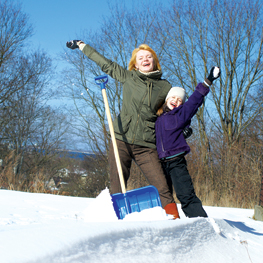
When I was a teenager, I spent a day over the holidays volunteering in a soup kitchen with my mother. It was both an eye-opening and a wonderful experience. I really felt like I was doing something good for the world. But after the experience was over, I soon forgot about the entire thing and went back to my self-absorbed teenage self. It wasn’t until I was an adult that I discovered again the joy that comes with selfless giving.
Since then, I’ve learned that you don’t need to wait until your teenage years to learn the joys of charitable generosity. According to parenting expert Julie Freedman Smith of Calgary’s Parenting Power, you can introduce the concept to your children as early as three years old. At that age, you may have started some form of allowance, and there may be some discussion in your family about the value of money and time. Plus, at three years old, your child may be starting activities away from the family, such as preschool or daycare.
“They’re starting to realize that different families have different things,” says Freedman Smith. “Their world has expanded.”
To begin with, you can explain to your child that not everyone will get toys this Christmas and not everyone has enough food in their tummies. The holiday season offers plenty of opportunities to introduce this concept to your children. Though you may worry that your three-year-old is too young to offer much help, they are definitely old enough to contribute in small ways. Just keep their efforts simple and you can help them feel the joy of giving to someone else.
Some charitable ideas appropriate for your youngsters include the following:
Go out as a family and become a team of snow angels for a disabled or senior neighbor. Young children will happily shovel a sidewalk alongside a parent.
Bake some cookies and donate them to a nursing home.
Keep a donation jar in your house and start a family fund for charity. Ask everyone to donate a portion of their allowance to the fund. Use the money your family pools together to buy toys for a local toy drive, such as the Salvation Army Angel Tree.
The next step in growing your child’s charitable spirit is to make selfless giving a part of your family’s habits year-round.
“If charitable giving is part of your family values, then try to live that as much as you can throughout the year,” says Freedman Smith.
For example, a team of snow angels can become a team of lawn mowing angels in the summer or a team of leaf raking angels in the Fall. Everyone can continue to contribute to the family fund after the holidays to support your choice of charities year round, such as The Calgary Food Bank or The Calgary Poppy Fund.
In time, you will teach your children that they aren’t the only person in the world. If you plant the seed of charitable giving within them, they learn that we help others, and that others help us.
Finally, it is important to note that rewarding or excessively praising your child for their charitable acts should be avoided. According to Parenting Power, too much praise for a good deed distracts your child from the internal reward of the joy of giving. You want to avoid teaching your child that a charitable act is done simply to gain a reward and instead allow them to simply enjoy the positive feelings one has when they give.
“The joy of giving is the reward for giving,” says Freedman Smith.
Liesa is a freelance writer who is absolutely smitten with her hometown of Calgary. You can view more of her work by visiting www.liesaevans.com.
Calgary’s Child Magazine © 2024 Calgary’s Child